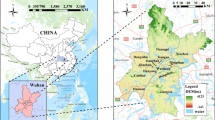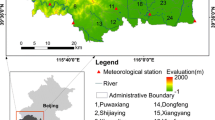Abstract
Flood risk assessment and risk level zonation is very important for preventing the watershed flood disaster and making disaster mitigation plans. We establish a flood disaster risk assessment model based on GIS and natural disaster risk assessment theory. We build up a risk assessment index system based on hazard of natural environment and vulnerability of economic society. Furthermore, we propose two indices, reservoir storage modulus and flood detention basin modulus, and use them to characterize human intervention capability on flood in the hazard index set. To reduce the occurrence of the inconsistency problems when using analytic hierarchy process (AHP) method in multi-indices comparison, we use the coupled AHP and expert scoring method to determine the weights of indices. We apply the methodology to the Huaihe River basin. The results show that the multi-year average risk zonation map from 1960 to 2010 is consistent with the historical flood disaster distribution, which verifies the applicability of this method in flood disaster risk assessment.






Similar content being viewed by others
References
Castillo-Rodriguez JT, Escuder-Bueno I, Altarejos-Garcia L, Serrano-Lombillo A (2014) The value of integrating information from multiple hazards for flood risk analysis and management. Nat Hazard Earth Sys 14:379–400. doi:10.5194/nhess-14-379-2014
Chen YR, Yeh CH, Yu BF (2011) Integrated application of the analytic hierarchy process and the geographic information system for flood risk assessment and flood plain management in Taiwan. Nat Hazards 59:1261–1276. doi:10.1007/s11069-011-9831-7
Chen S, Luo ZK, Pan XB (2013) Natural disasters in China: 1900–2011. Nat Hazards 69:1597–1605. doi:10.1007/s11069-013-0765-0
Dutta D, Alam J, Umeda K, Hayashi M, Hironaka S (2007) A two-dimensional hydrodynamic model for flood inundation simulation: a case study in the lower Mekong river basin. Hydrol Process 21:1223–1237. doi:10.1002/Hyp.6682
Guo EL, Zhang JQ, Ren XH, Zhang Q, Sun ZY (2014) Integrated risk assessment of flood disaster based on improved set pair analysis and the variable fuzzy set theory in central Liaoning Province, China. Nat Hazards 74:947–965. doi:10.1007/s11069-014-1238-9
Haynes H, Haynes R, Pender G (2008) Integrating socio-economic analysis into decision-support methodology for flood risk management at the development scale (Scotland). Water Environ J 22:117–124. doi:10.1111/j.1747-6593.2007.00086.x
Jenks GF (1967) The data model concept in statistical mapping. Int Yearb Cartogr 7:186–190
Ji ZH, Li N, Xie W, Wu JD, Zhou Y (2013) Comprehensive assessment of flood risk using the classification and regression tree method. Stoch Env Res Risk A 27:1815–1828. doi:10.1007/s00477-013-0716-z
Jiang WG, Deng L, Chen LY, Wu JJ, Li J (2009) Risk assessment and validation of flood disaster based on fuzzy mathematics. Prog Nat Sci 19:1419–1425. doi:10.1016/j.pnsc.2008.12.010
Li GF, Xiang XY, Tong YY, Wang HM (2013) Impact assessment of urbanization on flood risk in the Yangtze River Delta. Stoch Env Res Risk A 27:1683–1693. doi:10.1007/s00477-013-0706-1
Liu JF, Li J, Liu J, Cao RY (2008) Integrated GIS/AHP-based flood risk assessment : a case study of Huaihe River Basin in China. J Nat Disasters 17(6):110–114 (in Chinese)
Liu J, Jiang WG, Du PJ, Sheng SX, Liu JF, Cao RY (2009) Rainstorm risk assessment of Huaihe River based on correlation analysis. J China Univ Min Technol 38(5):735–740 (in Chinese)
Liu JF, Liang YH, Ma GB (2010) Huaihe River valley flood risk assessment based on GIS. J Anhui Agric Sci 38(5):2510–2511 + 2561 (in Chinese)
Mani P, Chatterjee C, Kumar R (2014) Flood hazard assessment with multiparameter approach derived from coupled 1D and 2D hydrodynamic flow model. Nat Hazards 70:1553–1574. doi:10.1007/s11069-013-0891-8
Maskrey A (1989) Disaster mitigation: a community based approach, vol 3. Oxfam, Oxford
Mazzoleni M, Bacchi B, Barontini S, Di Baldassarre G, Pilotti M, Ranzi R (2014) Flooding hazard mapping in floodplain areas affected by piping breaches in the Po river, Italy. J Hydrol Eng 19:717–731
Saaty TL (1980) The analytic hierarchy process. McGraw-Hill, New York
Sinha R, Bapalu GV, Singh LK, Rath B (2008) Flood risk analysis in the Kosi river basin, north Bihar using multi-parametric approach of analytical hierarchy process (AHP). J Indian Soc Remote Sens 36(4):335–349
Stefanidis S, Stathis D (2013) Assessment of flood hazard based on natural and anthropogenic factors using analytic hierarchy process (AHP). Nat Hazards 68:569–585. doi:10.1007/s11069-013-0639-5
Tingsanchali T, Karim MF (2005) Flood hazard and risk analysis in the southwest region of Bangladesh. Hydrol Process 19:2055–2069. doi:10.1002/Hyp.5666
UNDRO (1991) Mitigating natural disasters : phenomena, effects and options : a manual for policy makers and planners. United Nations, New York
Wang YM, Li ZW, Tang ZH, Zeng GM (2011) A GIS-based spatial multi-criteria approach for flood risk assessment in the Dongting Lake Region, Hunan, Central China. Water Resour Manag 25:3465–3484. doi:10.1007/s11269-011-9866-2
Wang Y, Ding YJ, Ye BS, Liu FJ, Wang J, Wang J (2013) Contributions of climate and human activities to changes in runoff of the yellow and Yangtze rivers from 1950 to 2008. Sci China Earth Sci 56:1398–1412. doi:10.1007/s11430-012-4505-1
Xiang LY (2004) Study on flood risk assessment index system. J Develop Water Conser 8:25–29 (in Chinese)
Yoon DK (2012) Assessment of social vulnerability to natural disasters: a comparative study. Nat Hazards 63:823–843. doi:10.1007/s11069-012-0189-2
Zhang YL, You WJ (2014) Social vulnerability to floods: a case study of Huaihe River Basin. Nat Hazards 71:2113–2125. doi:10.1007/s11069-013-0996-0
Zou Q, Zhou JZ, Zhou C, Song LX, Guo J (2013) Comprehensive flood risk assessment based on set pair analysis-variable fuzzy sets model and fuzzy AHP. Stoch Env Res Risk A 27:525–546. doi:10.1007/s00477-012-0598-5
Acknowledgments
This study is supported by the National Natural Science Foundation of China (Grant No. 51179044/51379055), the National Basic Research Program of China (973 Program, Grant No. 2010CB951102).
Author information
Authors and Affiliations
Corresponding author
Rights and permissions
About this article
Cite this article
Wu, Y., Zhong, Pa., Zhang, Y. et al. Integrated flood risk assessment and zonation method: a case study in Huaihe River basin, China. Nat Hazards 78, 635–651 (2015). https://doi.org/10.1007/s11069-015-1737-3
Received:
Accepted:
Published:
Issue Date:
DOI: https://doi.org/10.1007/s11069-015-1737-3




